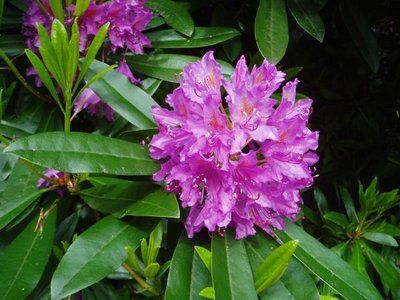
My fascination with poisonous plants was piqued recently while researching organic methods for eliminating rhododendron root weevils.
You’ve probably seen their damage-scalloped or notched leaf margins starting in May or June. The adult weevils feed at night but usually do not seriously injure the plant. It’s the larvae feeding unseen on roots that will cause severe damage and death of the plant, if weevils are left uncontrolled.
Because rhododendrons contain toxic resins that are more concentrated in the foliage, weevils have developed a resistance to pesticides along with their tolerance for the toxins in the leaves. Organic and even chemical sprays have little effect these days, according to a study funded by the Rhododendron Society of America, and end up killing hundreds more predatory beetles and other beneficial insects in the process.
Applying parasitic nematodes to the garden soil is one way to control weevils. Other tactics include placing a shallow pan of water under the plant or a soup can filled with soapy water buried up to the rim to attract and drown the adults. You can also try banding rhododendron trunks with tape or waterproof paper and smearing the bands with a sticky barrier, such as Tanglefoot. Spreading coffee grounds under the plants also helps to discourage weevils from crawling up the trunk after they spend the night at the base of the plant. And if you’re really determined, you can hand-pick them after dark — effective, but not much fun.
Rhododendrons are just one of our beautiful plants that are poisonous. Children are more susceptible to plant toxins than adults and should be taught not to eat seeds, berries or leaves from any plant. Do not assume a plant is nontoxic because birds or wild animals can consume it without harm. Be prepared for an emergency by keeping syrup of ipecac on hand and the number of the Poison Control Center (800-222-1222).
Small pets can also be at risk if they ingest parts of poisonous plants out in the yard.
Know what plants you have and keep a list. Oleander and foxglove are notoriously deadly plants. Here are just some others you might not know:
Among ornamentals, hydrangea leaves, flowers and branches contain cyanide. Lantana foliage and especially unripe berries also contain dangerous toxins, while delphinium leaves and seeds contain toxic alkaloids that decrease as the plant ages. Sweet peas, lobelias, impatiens, carnations, calla lilies, mums and bleeding hearts also have plant parts that cause some degree of trouble if ingested.
Surprisingly, even some vegetables contain natural toxins.
Diseased celery and green potatoes, as well as potato leaves and sprouts, produce a very strong toxin. Raw, green, young asparagus shoots can cause dermatitis, and the red berries that form on their feathery branches are poisonous.
In large quantities, tomato leaves and stems contain alkaloid poisons — livestock have died from eating the foliage. I guess the deer that browse our tomato vines aren’t ingesting enough to cause them harm, as they seem to know just when there’s another set of buds for them to nibble.
Trees are not the most common cause of accidental poisonings around the home, but a few species may present a hazard.
The black seeds inside apples contain cyanide although you have to eat large quantities for them to be deadly. Peach kernels, bark and twigs also contain cyanide, as do apricot, cherry and plum pits.
You don’t have to eliminate plants around the home that produce natural toxins. Humans have lived safely for centuries around gardens and orchards. Just be prepared by knowing what plants grow on your property.
Jan Nelson, a California certified nursery professional at Plant Works in Ben Lomond, will answer questions about gardening in the Santa Cruz Mountains. E-mail her at ja******@*ol.com.











